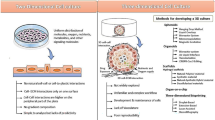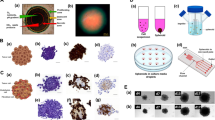Abstract
Two dimensional (2D) cell culture systems lack the ability to mimic in vivo conditions resulting in limitations for preclinical cell-based drug and toxicity screening assays and modelling tumor biology. Alternatively, 3D cell culture systems mimic the specificity of native tissue with better physiological integrity. In this regard, microfluidic chips have gained wide applicability for in vitro 3D cancer cell studies. The aim of this research was to develop a 3D biomimetic model comprising culture of breast cancer cells in butterfly-shaped microchip to determine the cytotoxicity of carnosic acid and doxorubicin on both estrogen dependent (MCF-7) and independent (MDA-MB231) breast cancer cells along with healthy mammary epithelial cells (MCF-10A) in 2D, 3D Matrigel™ and butterfly-shaped microchip environment. According to the developed mimetic model, carnosic acid exhibited a higher cytotoxicity towards MDA-MB 231, while doxorubicin was more effective against MCF-7. Although the cell viabilities were higher in comparison to 2D and 3D cell culture systems, the responses of the investigated molecules were different in the microchips based on the molecular weight and structural complexity indicating the importance of biomimicry in a physiologically relevant matrix.






Similar content being viewed by others
References
Antoni D, Burckel H, Josset E, Noel G (2015) Three-dimensional cell culture: a breakthrough in vivo International journal of molecular sciences 16:5517–5527
Baker BM, Chen CS (2012) Deconstructing the third dimension–how 3D culture microenvironments alter cellular cues. J Cell Sci 125:3015–3024
Baudoin R, Griscom L, Prot JM, Legallais C, Leclerc E (2011) Behavior of HepG2/C3A cell cultures in a microfluidic bioreactor. Biochem Eng J 53:172–181
Dolega ME, Abeille F, Picollet-D’hahan N, Gidrol X (2015) Controlled 3D culture in Matrigel microbeads to analyze clonal acinar development. Biomaterials 52:347–357
Elliott NT, Yuan F (2011) A review of three-dimensional in vitro tissue models for drug discovery and transport studies. J Pharm Sci 100:59–74
Ghaemmaghami AM, Hancock MJ, Harrington H, Kaji H, Khademhosseini A (2012) Biomimetic tissues on a chip for drug discovery. Drug Discov Today 17:173–181
Håkanson M, Cukierman E, Charnley M (2014) Miniaturized pre-clinical cancer models as research and diagnostic tools. Adv Drug Deliv Rev 69:52–66
He J, Reboud J, Ji H, Lee C, Long Y (2009) Development of microfluidic device and system for breast cancer cell fluorescence detection. J Vac Sci Technol, B 27:1295–1298
Hickman JA, Graeser R, de Hoogt R, Vidic S, Brito C, Gutekunst M, van der Kuip H (2014) Three-dimensional models of cancer for pharmacology and cancer cell biology: capturing tumor complexity in vitro/ex vivo. Biotechnol J 9:1115–1128
Hockemeyer K et al (2014) Engineered three-dimensional microfluidic device for interrogating cell-cell interactions in the tumor microenvironment. Biomicrofluidics 8:044105
Hwang H, Park J, Shin C, Do Y, Cho Y-K (2013) Three dimensional multicellular co-cultures and anti-cancer drug assays in rapid prototyped multilevel microfluidic devices. Biomed Microdevices 15:627–634
Kim D, Wu X, Young AT, Haynes CL (2014) Microfluidics-based in vivo mimetic systems for the study of cellular biology. Acc Chem Res 47:1165–1173
Knight E, Przyborski S (2015) Advances in 3D cell culture technologies enabling tissue-like structures to be created in vitro. J Anat 227:746–756
Komen J, Wolbers F, Franke HR, Andersson H, Vermes I, van den Berg A (2008) Viability analysis and apoptosis induction of breast cancer cells in a microfluidic device: effect of cytostatic drugs. Biomed Microdevices 10:727–737
Kunze A, Pushkarsky I, Kittur H, Di Carlo D (2014) Research highlights: measuring and manipulating cell migration. Lab Chip 14:4117–4121
Lee GY, Kenny PA, Lee EH, Bissell MJ (2007) Three-dimensional culture models of normal and malignant breast epithelial cells. Nat Methods 4:359–365
Masuda T, Inaba Y, Takeda Y (2001) Antioxidant mechanism of carnosic acid: structural identification of two oxidation products. J Agric Food Chem 49:5560–5565
Moreno-Arotzena O, Mendoza G, Cóndor M, Rüberg T, García-Aznar J (2014) Inducing chemotactic and haptotactic cues in microfluidic devices for three-dimensional in vitro assays. Biomicrofluidics 8:064122
Omri AEL, Han J, Abdrabbah MB, Isoda H (2012) Down regulation effect of Rosmarinus officinalis polyphenols on cellular stress proteins in rat pheochromocytoma PC12 cells. Cytotechnology 64:231–240
Ozdil B, Onal S, Oruc T, Okvur DP (2014) Fabrication of 3D controlled in vitro microenvironments. MethodsX 1:60–66
Patra B et al (2014) Migration and vascular lumen formation of endothelial cells in cancer cell spheroids of various sizes. Biomicrofluidics 8:052109
Pesen-Okvur D (2015) Microfluidic device for investigation of distance dependent interactions in cell biology Patent No WO 2015/052034 A1, World Intellectual Property Organization
Ravi M, Kaviya SR, Paramesh V (2016) Culture phases, cytotoxicity and protein expressions of agarose hydrogel induced Sp2/0, A549, MCF-7 cell line 3D cultures. Cytotechnology 68:429–441
Rios-Mondragon I, Wang X, Gerdes H-H (2012) Spatio-temporal analysis of tamoxifen-induced bystander effects in breast cancer cells using microfluidics. Biomicrofluidics 6:024128
Saadi W, Wang S-J, Lin F, Jeon NL (2006) A parallel-gradient microfluidic chamber for quantitative analysis of breast cancer cell chemotaxis. Biomed Microdevices 8:109–118
Song H, Chen T, Zhang B, Ma Y, Wang Z (2010) An integrated microfluidic cell array for apoptosis and proliferation analysis induction of breast cancer cells. Biomicrofluidics 4:044104
Sung KE, Beebe DJ (2014) Microfluidic 3D models of cancer. Adv Drug Deliv Rev 79:68–78
Tehranirokh M, Kouzani AZ, Francis PS, Kanwar JR (2013) Microfluidic devices for cell cultivation and proliferation. Biomicrofluidics 7:051502
Thierry B, Kurkuri M, Shi JY, Lwin LEMP, Palms D (2010) Herceptin functionalized microfluidic polydimethylsiloxane devices for the capture of human epidermal growth factor receptor 2 positive circulating breast cancer cells. Biomicrofluidics 4:032205
Thoma CR, Zimmermann M, Agarkova I, Kelm JM, Krek W (2014) 3D cell culture systems modeling tumor growth determinants in cancer target discovery. Adv Drug Deliv Rev 69:29–41
Weber P, Wagner M, Schneckenburger H (2013) Cholesterol dependent uptake and interaction of doxorubicin in MCF-7 breast cancer cells. Int J Mol Sci 14:8358–8366
Weigelt B, Ghajar CM, Bissell MJ (2014) The need for complex 3D culture models to unravel novel pathways and identify accurate biomarkers in breast cancer. Adv Drug Deliv Rev 69:42–51
Wong AP, Perez-Castillejos R, Love JC, Whitesides GM (2008) Partitioning microfluidic channels with hydrogel to construct tunable 3-D cellular microenvironments. Biomaterials 29:1853–1861
Wu J et al (2014) A compact microfluidic system for cell migration studies. Biomed Microdevices 16:521–528
Yesil-Celiktas O (2014) Patenting trends in enzyme related microfluidic applications. Biochem Eng J 92:53–62
Yesil-Celiktas O, Sevimli C, Bedir E, Vardar-Sukan F (2010) Inhibitory effects of rosemary extracts, carnosic acid and rosmarinic acid on the growth of various human cancer cell lines. Plant Foods Hum Nutr 65:158–163
Yildiz-Ozturk E, Yesil-Celiktas O (2015) Diffusion phenomena of cells and biomolecules in microfluidic devices. Biomicrofluidics 9:052606
Zheng W et al (2014) An on-chip study on the influence of geometrical confinement and chemical gradient on cell polarity. Biomicrofluidics 8:052010
Acknowledgements
Access to the Animal Cell and Tissue Engineering and Novel Fluidic Technologies Laboratories of Ege University, Department of Bioengineering is highly appreciated.
Author information
Authors and Affiliations
Corresponding author
Rights and permissions
About this article
Cite this article
Yildiz-Ozturk, E., Gulce-Iz, S., Anil, M. et al. Cytotoxic responses of carnosic acid and doxorubicin on breast cancer cells in butterfly-shaped microchips in comparison to 2D and 3D culture. Cytotechnology 69, 337–347 (2017). https://doi.org/10.1007/s10616-016-0062-3
Received:
Accepted:
Published:
Issue Date:
DOI: https://doi.org/10.1007/s10616-016-0062-3




